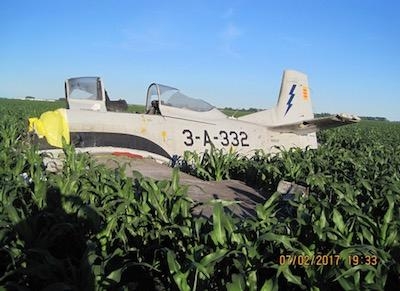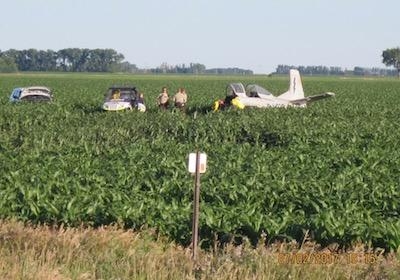Aircraft Impacted A Light Pole During Landing Approach
The NTSB has released its factual report from an accident involving a T-28 Trojan aircraft that was landing at Moorhead Municipal Airport (KJKJ), in Moorhead, MN.

According to the report, the aircraft, registered to and operated by the Trojan Corporation, Grand Forks, North Dakota, clipped a light pole and impacted terrain during the approach. The pilot, the sole occupant of the aircraft, was fatally injured.
The flight originated from Hector International Airport (KFAR), Fargo, NDa, at 1750 local time, and was originally en route to Lyons Field (47Y), Pelican Rapids, Minnesota.
According to the FAA inspector's statement, the airplane took off from runway 31 at KFAR and climbed to 1,800 feet mean sea level (msl), about 900 feet above ground level (agl), at 160 knots. Shortly after reaching 1,800 feet, the pilot radioed KFAR departure control and told them he was landing at KJKJ. The controller asked the pilot if he needed any assistance and the pilot replied, "I don't think so." The pilot was given clearance to land at JKJ and when asked again if he needed any assistance, he replied "No." The controller told the pilot that a frequency change was approved and squawk VFR (transponder code 1200) . There was no reply from the pilot. The controller advised the pilot that radar services were terminated. Again, there was no acknowledgement from the pilot. No further communications were made with the pilot. Radar showed the airplane in a controlled descent on a southerly heading towards JKJ. The decent distance from 1,800 feet msl to the point of impact was approximately 7.5 statute
miles (an average descent rate of 120 feet per mile). Field elevation at JKJ was 918 feet.
One witness, located 2 miles north of the accident site, saw the airplane fly over in a southerly direction at an estimated altitude of 150 to 200 feet agl with the landing gear extended. It was "obviously in distress." He said there was a "terrible racket" and sounded like "a gearbox or engine that was failing or out of oil." This witness submitted a written statement to FAA, which is included in this report's docket.

FAA telephonically interviewed two other witnesses who were in public park 2 miles north of the accident site. The first witness said they airplane flew over at an altitude of about 100 feet agl and that he could clearly see the pilot. He said the engine was missing and popping. The landing gear was down, but he did not notice the flap position. He watched the airplane all the way to impact. The second witness said the airplane was flying "very low" and "sounded like it was in trouble." He also watched the airplane impact the ground.
Clay County Sheriff's deputies interviewed 8 other witnesses, who corroborated what the other witnesses had reported. One noted that the airplane appeared to be flying slow and its wings were "rocking" before it clipped the light pole with its right wing. The light was destroyed but the pole was undamaged.
These witnesses and other passerby went the accident site to assist the pilot, who was conscious, coherent, and talking. A shirt was placed against a large laceration on the pilot's forehead. Shortly thereafter, the pilot succumbed to his injuries. He had to be extricated by emergency personnel.
The accident location was in a corn field, 600 feet south of the Moorhead DOT (Department of Transportation) weigh station, about 2 miles east of Moorhead, Minnesota, along I-94, and ½- mile from the approach end of JKJ's runway 12. According to the FAA inspector, there were two open fields and 4 roads between the public park and accident site. The pilot made no attempt to make an emergency landing in either field.
The pilot held a private pilot certificate with an airplane single-engine land rating. According to FAA documents, when he applied for medical certification in March 2017, he estimated his total flight time to be 791 hours. His flight time in the T-28A could not be determined. N9103F, serial number 51-7606, was manufactured by the North American Aircraft Corporation in 1951, and certificated in the experimental category. It was powered by a Wright R-1820 engine, rated at 1,475 horsepower.
(Source: NTSB. Images from accident docket)
 ANN's Daily Aero-Linx (12.03.25)
ANN's Daily Aero-Linx (12.03.25) ANN's Daily Aero-Term (12.03.25): CrewMember (UAS)
ANN's Daily Aero-Term (12.03.25): CrewMember (UAS) NTSB Prelim: Maule M-7-235A
NTSB Prelim: Maule M-7-235A Airborne-Flight Training 12.04.25: Ldg Fee Danger, Av Mental Health, PC-7 MKX
Airborne-Flight Training 12.04.25: Ldg Fee Danger, Av Mental Health, PC-7 MKX Aero-News: Quote of the Day (12.04.25)
Aero-News: Quote of the Day (12.04.25)




